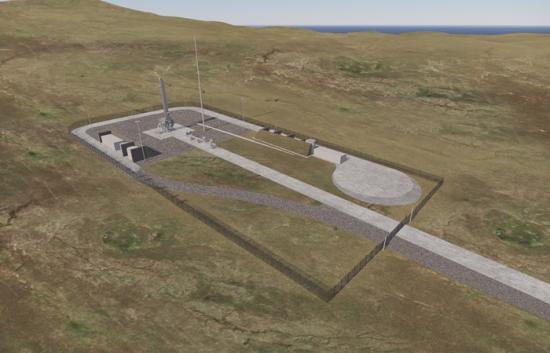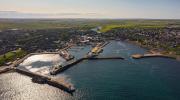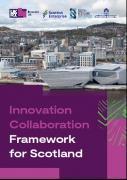Space Hub In Sutherland Wins Planning Approval
20th August 2020

Ambitious plans to launch satellites into orbit from the north Highlands of Scotland have been approved by the area's local authority.
Ambitious plans to launch satellites into orbit from the north Highlands of Scotland have been approved by the area's local authority.
Development agency Highlands and Islands Enterprise (HIE) intends to create Space Hub Sutherland on land owned by Melness Crofters Estate on the A’ Mhòine peninsula, south of Tongue.
HIE had submitted plans in February this year, including an extensive environmental impact assessment. Following a period of public consultation, these were considered on 26 June by the Highland Council North Planning Applications Committee.
Although the committee was minded to approve the application, the council was required to notify Scottish Ministers, as part of arrangements to ensure government overview of spaceport planning applications.
On 3 August, the Scottish Government announced that ministers did not intend to intervene and the council was free to determine the outcome of HIE’s application, which it has now done.
The decision means that small commercial satellites and launch vehicles designed and manufactured in Scotland could be taking off from Sutherland within the next few years.
Up to 12 launches a year will be permitted from the spaceport, which will include a control centre, 2.5km of road and a launch pad, occupying a total of just over 10 acres of the 740-acre site.
HIE has approved a budget of £17.3m to develop Space Hub Sutherland, including funding from the UK Space Agency and the Nuclear Decommissioning Authority.
Planning approval is subject to a set of 34 conditions, including measures to ensure operations are carried out safely and strict protection measures are implemented and monitored to protect the natural environment.
Scottish Government Innovation Minister Ivan McKee said:"I very much welcome the decision of the Highland Council to approve the planning application for Space Hub Sutherland, which will support around 250 well-paid jobs in the Highlands and Islands, including 61 in Caithness and Sutherland.
“This is the first of Scotland’s spaceport projects to clear the planning process and it represents a significant step forward for both the project and Scotland’s aspiration to offer the full end to end capability for manufacturing and launching small satellites and analysing their data.
“The space sector has a key role to play in the fight against global climate change and this milestone has been achieved through the hard work of the Sutherland team in partnership with the local community, leading experts and public bodies."
Graham Turnock, CEO, UK Space Agency said:“Growing our domestic launch capability will bring new jobs and investments to communities in all corners of the UK. Space Hub Sutherland is an integral part of these plans and today’s news strengthens our position as Europe’s leading destination for small satellite launches.
“The UK government is committed to minimising the environmental impact of spaceflight activities and is developing a National Space Strategy which recognises the unique contribution of satellite technology to our understanding of global issues like climate change.”
David Oxley, director of business growth with HIE, also welcomed the council’s decision.
“The UK’s space ambitions present a wonderful opportunity for the Highlands and Islands,” he said.
“A vertical launch spaceport is a key piece of the national jigsaw, along with the design and manufacture of satellites and launch vehicles, that will ensure Scotland can derive maximum economic benefits from this growing and exciting sector.
“Another important aspect is the role that satellites launched from Sutherland will play in gathering data that will help people around the world to understand and address the impacts of climate change.
“In developing our plans, we have always been very mindful of the environmental challenges presented by a project of this kind. Part of our ambition is to create the world’s most low-carbon space centre and the conditions applied to the planning approval will help us make that a reality.
“When all these factors are put together, that makes today’s decision a good result not just for the economy, but for the environment as well.”
Related Businesses
Related Articles
Workforce North event spotlights Highland economy
EMPLOYERS and educators from across the Highlands have gathered to hear how a new initiative is aiming to transform the region's economy. Workforce North - A Call to Action brought together business leaders and teachers from primary and secondary schools from across the Highland Council area with a wide range of partners geared towards education, learning and skills development at Strathpeffer Pavillion.
Tartan challenge for UHI students offers £1,500 prize
Students from across the University of the Highlands and Islands (UHI) partnership have been challenged to design a tartan and be in with a chance of winning a £1,500 cash prize. Highlands and Islands Enterprise (HIE) has launched THE COMPETITION to mark 60 years since the regional development agency (then named Highlands and Islands Development Board) was established in November 1965.
The Rural AI Roadshow - How AI can help your rural business thrive
Scotland's enterprise agencies (Scottish Enterprise, Highlands and Islands Enterprise, South of Scotland Enterprise) The Scottish AI Alliance and The Data Lab have joined forces to plan and deliver an inspiring and educational Rural AI Roadshow. There will be three, one day, Rural AI Roadshow conferences taking place across Scotland in January 2026.
Digital and AI innovation round-up for November
Scotland's digital future is accelerating, with AI and tech innovation transforming businesses. In this blog, HIE's Theresa Swayne shares November insights on funding, leadership, and how organisations can harness technology to stay ahead.
Reflections from SEWF Rural: global lessons for the Highlands and Islands social impact economy
As we mark 60 years since the region's economic and community development agency was established, it's timely to reflect on the global aspects of our work on shaping rural futures. The recent Social Enterprise World Forum (SEWF) Rural Gathering in Sabah, Malaysia, welcomed changemakers from Australia, Ireland, India, Canada.
Scottish Entrepreneurial Ecosystem Guide - FREE To Download
Scottish Enterprise's Entrepreneurial Ecosystem Guide provides an overview of more than 150 organisations that support new and growing companies in Scotland. The guide includes incubators, accelerators, specialist industry programmes, co-working spaces and networking organisations.
Funding approved for Wick Harbour port consultant
A specialist ports consultant has been appointed to develop a long-term strategic plan for Wick Harbour Authority (WHA) in Caithness. WHA has secured £47,775 from Highlands and Islands Enterprise (HIE) and the Nuclear Restoration Services, NRS Dounreay towards the cost of the services.
Enterprise and innovation agencies join forces in new framework
Scotland's three enterprise agencies have joined the UK's national innovation agency to agree a collaboration framework that aims to help Scotland become one of the most innovative small nations in the world. The Innovation Collaboration Framework for Scotland brings together Highlands and Islands Enterprise, Scottish Enterprise, South of Scotland Enterprise and Innovate UK with a commitment to support ambitious businesses to invest in research to drive economic growth, create good jobs and help tackle major societal and environmental challenges.
£3.4m HIE investment in Arnish Road, Stornoway
The project, led by the Stornoway Port Authority, will involve upgrading the full length of the 3.3km Arnish Moor Road. Highlands and Islands Enterprise (HIE) has approved a £3.4m contribution to a £7.2m public funding package for a major project to transform road access to strategic industrial and port sites on the Isle of Lewis.
As HIE reaches 60, new chair says best is yet to come
The newly appointed chair of Highlands and Islands Enterprise (HIE) says the region is on the threshold of a new era of economic growth. Angus Campbell's term as chair began officially on 1 November - 60 years to the day since HIE's forerunner, the Highlands and Islands Development Board (HIDB) opened for business with just six employees.
